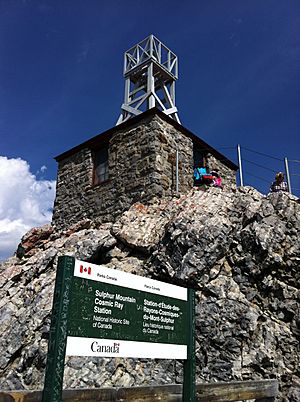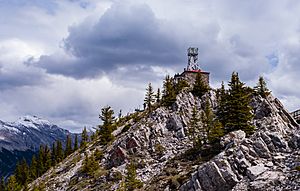Sulphur Mountain Cosmic Ray Station facts for kids
Quick facts for kids Sulphur Mountain Cosmic Ray Station |
|
|---|---|

View of the weather station perched on the summit of Sulphur Mountain just above where the dismantled Cosmic Ray Station once stood
|
|
| Location | Banff, Banff National Park, Alberta, Canada |
| Elevation | 2,283 m (7,490 ft) |
| Founder | National Research Council |
| Built | 1956 |
| Governing body | Parks Canada |
| Website | Parks Canada page |
| Designated | 1982 |
| Lua error in Module:Location_map at line 420: attempt to index field 'wikibase' (a nil value). | |
The Sulphur Mountain Cosmic Ray Station was a special science lab located high up on Sulphur Mountain. This mountain is found in Banff National Park in Canada. The station helped Canada take part in a big worldwide science project called the International Geophysical Year (IGY). This project happened from 1957 to 1958.
Scientists used the station to study cosmic rays. These are tiny, super-fast particles that come from outer space. Canada built nine stations to study cosmic rays, but the one on Sulphur Mountain was the most important. This was because it was so high up, making it easier to detect these particles. The National Research Council built the lab in the winter of 1956–57. They made sure the building could not be seen from the nearby town of Banff.
Contents
What Was the Station For?
The Sulphur Mountain station was a key part of the International Geophysical Year. This was a time when scientists from many countries worked together. They studied Earth and space. The station's main job was to measure cosmic rays. These rays constantly hit our planet.
How Did It Work?
The station used a special tool called an IGY neutron monitor. This device helped scientists count and study the cosmic rays. Dr. B. G. Wilson led the work at the station. He had two assistants helping him.
Who Ran the Station?
The National Research Council ran the station until 1960. After that, the University of Calgary took over. Dr. Wilson also moved to the University of Calgary. In 1963, a newer and better neutron monitor was put in place. However, the older IGY monitor kept working until 1972.
End of an Era
The Sulphur Mountain Cosmic Ray Station stopped its operations in 1978. The building was taken down in 1981. Even though the building is gone, the site is still important. In 1982, it was named a National Historic Site of Canada. This means it is a place that tells an important part of Canada's history. Today, a special plaque marks the exact spot where the station once stood.
Images for kids



